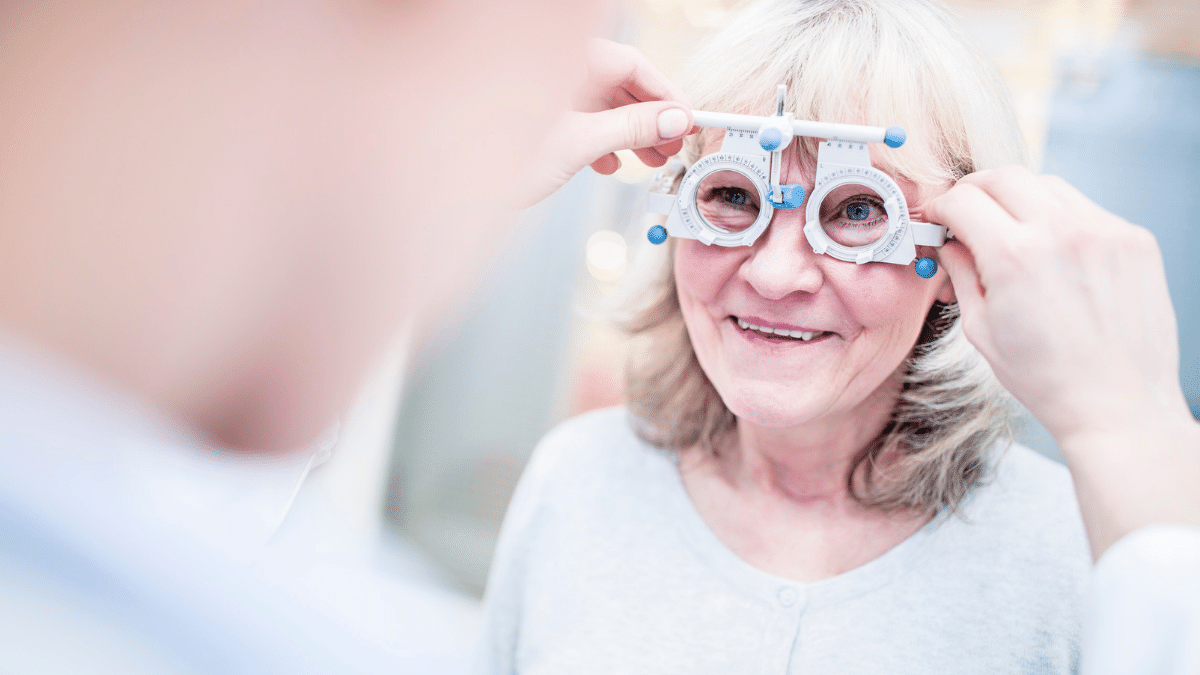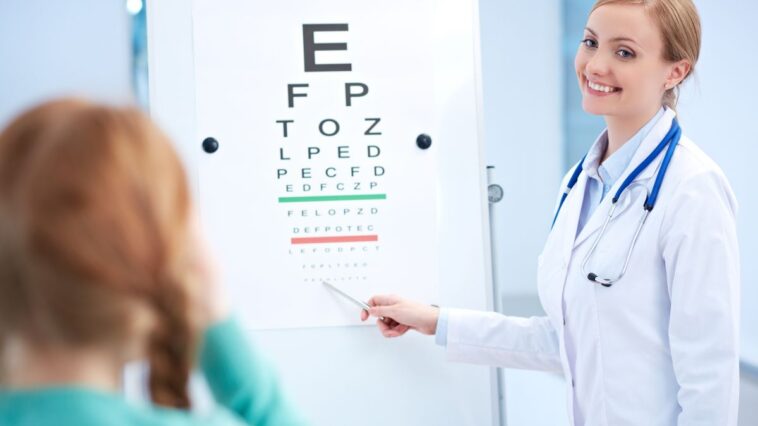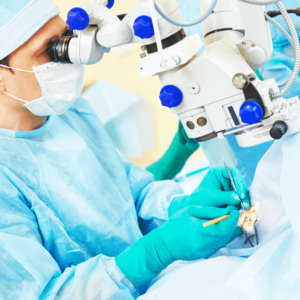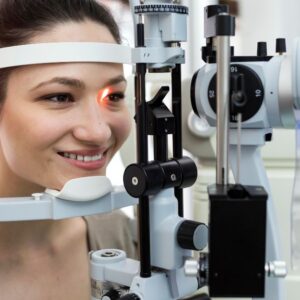What Does an Eye Test Measure?
An eye test, also known as an eye exam, measures various aspects of a person’s vision and health. During the test, an optometrist or ophthalmologist will check for visual acuity, which is the clarity or sharpness of vision. This is typically done using a Snellen chart, which consists of rows of letters that get smaller as you move down the chart. The patient will be asked to read the letters from a distance, and the smallest line they can read correctly will be recorded as their visual acuity.
In addition to visual acuity, an eye test also measures a person’s refractive error, which is the extent to which the eye can focus light correctly; this is done using a phoropter machine, which allows the optometrist to change the power of the lenses in front of the eyes.
The optometrist will also check for any signs of eye disease, such as cataracts, glaucoma, and macular degeneration, and examine the eye’s internal structure using an ophthalmoscope. The test also includes checking the health and function of the eye muscles and how well the eyes work together.
How Do Eye Tests Help Diagnose Vision Problems?
Eye tests are a crucial tool for identifying and diagnosing vision problems. They can measure visual acuity and the sharpness of vision and determine whether a person needs glasses or contact lenses to correct any refractive errors. A refraction test measures the need for glasses or contact lenses and assesses the eye’s focusing power. This test can detect nearsightedness, farsightedness, and astigmatism.
Eye tests also assess the eyes’ overall health and detect early eye disease signs. A dilated eye exam is one such test that allows the eye doctor to examine the retina and other parts of the eye for signs of disease, such as cataracts, glaucoma, and age-related macular degeneration. This test is performed by dilating the pupil, which makes it easier to see the inside of the eye. Eye tests can detect other vision issues, such as color blindness and depth perception problems. This helps in the early detection and prevention of vision loss and eye diseases.

What Is Refraction Testing?
Refraction testing is a procedure used to measure the eye’s refractive error or how light is bent as it passes through the eye. It is used to determine the need for glasses or contact lenses and to assess the eye’s focusing power. The test is performed by an eye doctor, typically an optometrist or an ophthalmologist, and can detect nearsightedness, farsightedness, and astigmatism.
During a refraction test, the eye doctor will use a phoropter, which has a series of lenses of different strengths that can be placed in front of the eye. The doctor will ask the patient to look at an eye chart and then adjust the lenses in the phoropter until the patient can see the letters on the chart. This process helps to determine the patient’s prescription for glasses or contact lenses.
Refraction tests can also be performed using an autorefractor, a machine that automatically measures the refractive error of the eye without the need for the patient’s feedback. This test is quick, painless, and a good test for the initial screening of refractive errors.
Refraction testing is a critical part of the eye examination process and helps ensure that the patient can see clearly and comfortably. It is usually done as part of a comprehensive eye exam, which may include other tests such as visual acuity testing, dilation, eye examination, and tonometry.
Are There Any Risks or Complications Associated With Having an Eye Test?
Generally, eye tests are considered safe and have minimal risks or complications. However, there are a few potential risks or complications associated with certain types of eye tests:
- Dilated eye exam: Eye dilation is performed using eye drops, which can cause the pupils to dilate and cause sensitivity to light and blurry vision for several hours after the exam.
- Tonometry: This test measures the pressure inside the eye and can cause mild discomfort, but it is not typically painful.
- Retinal imaging: Some types of retinal imaging, such as optical coherence tomography (OCT), may be associated with a small risk of retinal detachment, particularly in people who are at a higher risk for this condition.
- Electrodiagnostic testing: There is a small risk of burns or injury to the eye from the electrodes.
- Some people may feel mild discomfort or pressure from the phoropter during a refraction test, but it is usually not painful.
It is important to note that these potential risks and complications are rare, and most people experience no problems with eye tests. Your eye doctor will inform you about any potential risks and complications of the tests to be performed on you and answer any questions you may have.
If you are concerned about the risks or complications associated with a particular type of eye test, discuss this with your eye doctor before the test is performed.
How can Refraction Testing Reveal Visual Acuity?
During a refraction test, the patient is asked to look at an eye chart, typically a Snellen chart which displays letters of decreasing size. The doctor will then adjust the lenses in the phoropter until the patient can see the letters on the chart. This process helps to determine the patient’s prescription for glasses or contact lenses and their visual acuity.
Visual acuity is measured by asking the patient to read letters or numbers on a chart from a specific distance. The patient’s ability to read the smallest line of letters on the chart determines their visual acuity.
A normal visual acuity is considered to be 20/20, which means that the patient can read a letter from a distance of 20 feet, that a person with normal vision can read from 20 feet. If the patient can’t read the smallest line of letters, the visual acuity is considered less than 20/20; for example, 20/40 means the patient needs to be closer to seeing the same letter than a person with normal vision.
Refraction testing and visual acuity testing are closely related, and both are important in determining the patient’s overall visual function. The refraction test helps to determine the patient’s prescription for glasses or contact lenses, while the visual acuity test helps to determine the sharpness of the patient’s vision. Together, these tests provide a comprehensive evaluation of the patient’s visual function and help ensure that the patient can see clearly and comfortably.
Other Medical Issues Detected By an Eye Exam?
An eye exam can detect many medical issues, not just those related to vision. During an eye exam, the eye doctor will perform various tests to evaluate the health and function of the eyes. Some of these tests can detect other medical issues as well, such as:
- High blood pressure: Tonometry, which measures the pressure inside the eye, can detect high blood pressure in the eye, which can be an indicator of hypertension.
- Diabetes: A dilated eye exam can detect diabetic retinopathy, a complication of diabetes that affects the retina.
- Thyroid disease: A dilated eye exam can detect Graves’ disease, a type of thyroid disease that causes the eyes to bulge.
- Autoimmune disorders: A dilated eye exam can detect Scleritis, which is an inflammation of the sclera (white of the eye) that is associated with autoimmune disorders such as rheumatoid arthritis, lupus, and sarcoidosis.
- Neurological disorders: Visual field testing can detect neurological disorders such as brain tumors, multiple sclerosis, and stroke.
- Cancer: A dilated eye exam can detect tumors and cancerous growths in and around the eye, such as melanomas, basal cell carcinomas, and squamous cell carcinomas.
- Anemia: A pale conjunctiva can indicate anemia, a lack of iron in the blood.
- Inflammation and infection: Eye exams can detect signs of inflammation or infection in the eye, such as conjunctivitis, uveitis, and keratitis.
- Dry eye: A dry eye can be indicated by dry spots, inflammation or redness on the eye surface or abnormal tear production.
- Systemic diseases: Some systemic diseases like sarcoidosis, lupus, and others can affect the eye, and eye exams can detect these conditions early on.
Only some of these issues will be detected in every individual, and the eye doctor will determine which tests are appropriate for you based on your needs and medical history.
How Often Should You Get an Eye Test?
The frequency of eye exams can vary depending on a person’s age, overall health, and risk factors for eye disease. The American Academy of Ophthalmology recommends the following schedule for comprehensive eye exams:
- Children: At least one comprehensive eye exam by age 3, and then again before starting school.
- Adults (ages 20 to 39): A comprehensive eye exam every 10 years or as needed.
- Adults (ages 40 to 64): A comprehensive eye exam every 5 to 10 years or as needed.
- Adults (age 65 and older): A comprehensive eye exam every 1 to 2 years or as needed.
- People at high risk of eye disease: More frequent eye exams may be recommended for people who have a family history of eye disease, diabetes, high blood pressure, or other conditions that increase the risk of eye disease.
It’s important to note that these are general guidelines, and your eye doctor may recommend more frequent or less frequent eye exams based on your individual needs and medical history.
It’s also essential to have regular check-ups, even if you have no symptoms, as some eye diseases do not have symptoms in the early stages. Regular eye exams can detect these conditions early on, when they are most treatable, and prevent vision loss.
What Do Eye Tests Reveal About Your Vision
Eye tests can reveal a variety of information about a person’s vision, including their visual acuity (sharpness of vision), refractive errors (nearsightedness, farsightedness, astigmatism), and the health of their eyes. They can also detect cataracts, glaucoma, and age-related macular degeneration. Additionally, eye tests can be used to determine the need for glasses or contact lenses and monitor changes in vision over time.
Summary
In conclusion, eye tests are an essential tool for assessing and maintaining the health of our eyes. They can reveal a wide range of information about our vision, including visual acuity, refractive errors, and potential health issues.
Regular eye tests can detect these issues early on, allowing for prompt treatment and potentially preserving vision. Additionally, eye tests can help determine the need for corrective lenses and monitor changes in vision over time. Overall, regular eye tests are essential to maintaining good eye health.






